park assist MERCEDES-BENZ R-CLASS FAMILY TOURER 2013 Owners Manual
[x] Cancel search | Manufacturer: MERCEDES-BENZ, Model Year: 2013, Model line: R-CLASS FAMILY TOURER, Model: MERCEDES-BENZ R-CLASS FAMILY TOURER 2013Pages: 364, PDF Size: 28.68 MB
Page 6 of 364

Index
....................................................... 4Introduction
......................................... 21 At
ag lance ........................................... 29 Safety
................................................... 39 Opening/closing
................................. 75 Seats, steering wheel and mirrors
....99 Lights and windshield wipers
..........119 Climate control
................................. 133 Driving and parking
..........................147 On-board computer and displays
....199 Stowage and features
......................249 Maintenance and care
......................283 Breakdown assistance
.....................297 Wheels and tires
............................... 311 Technical data
................................... 347 Contents
3
Page 8 of 364
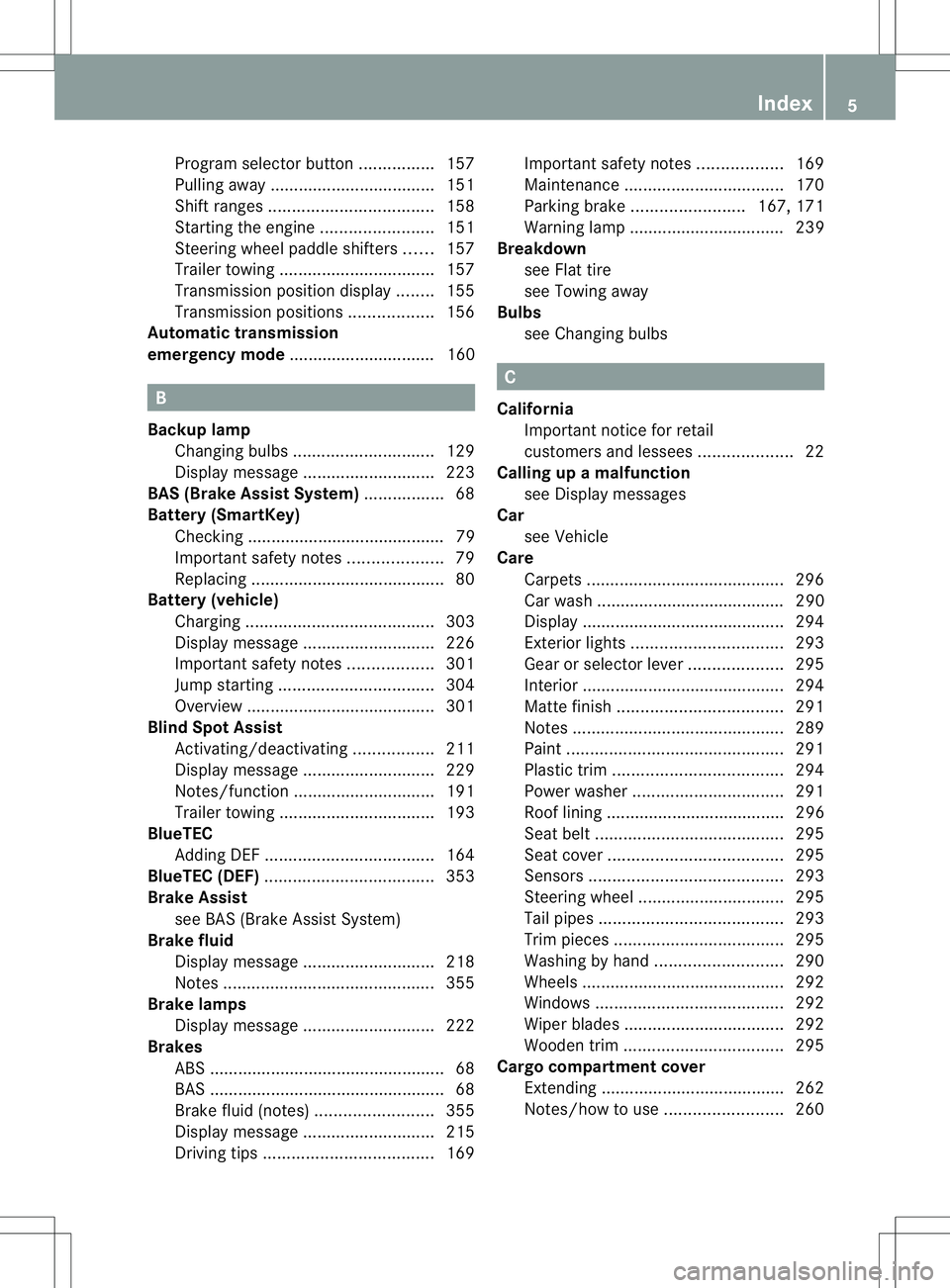
Program selector button
................157
Pulling away ................................... 151
Shift range s................................... 158
Starting the engine ........................151
Steering wheel paddle shifters ......157
Trailer towing ................................. 157
Transmissio nposition display ........155
Transmission positions ..................156
Automatic transmission
emergency mode ............................... 160 B
Backup lamp Changing bulbs .............................. 129
Display message ............................ 223
BAS (Brake Assist System) .................68
Battery (SmartKey) Checking .......................................... 79
Important safety notes ....................79
Replacing ......................................... 80
Battery (vehicle)
Charging ........................................ 303
Display message ............................ 226
Important safety notes ..................301
Jump starting ................................. 304
Overview ........................................ 301
Blin dSpot Assist
Activating/deactivating .................211
Display message ............................ 229
Notes/function .............................. 191
Trailer towing ................................. 193
BlueTEC
Adding DEF .................................... 164
BlueTEC (DEF) .................................... 353
Brake Assist see BAS (Brake Assist System)
Brake fluid
Display message ............................ 218
Notes ............................................. 355
Brake lamps
Display message ............................ 222
Brakes
ABS .................................................. 68
BAS .................................................. 68
Brake fluid (notes) .........................355
Display message ............................ 215
Driving tips .................................... 169Important safety notes
..................169
Maintenance .................................. 170
Parking brake ........................ 167, 171
Warning lamp ................................. 239
Breakdown
see Flat tire
see Towing away
Bulbs
see Changing bulbs C
California Important notice for retail
customers and lessees ....................22
Calling up a malfunction
see Display messages
Car
see Vehicle
Care
Carpets .......................................... 296
Car wash ........................................ 290
Display ........................................... 294
Exterior lights ................................ 293
Gea rors electo rlever .................... 295
Interior ........................................... 294
Matte finish ................................... 291
Notes ............................................. 289
Paint .............................................. 291
Plastic trim .................................... 294
Power washer ................................ 291
Roof lining ...................................... 296
Seat bel t........................................ 295
Seat cover ..................................... 295
Sensors ......................................... 293
Steering wheel ............................... 295
Tai lpipes ....................................... 293
Trim pieces .................................... 295
Washing by hand ........................... 290
Wheels ........................................... 292
Windows ........................................ 292
Wiper blades .................................. 292
Wooden trim .................................. 295
Cargo compartment cover
Extending ...................................... .262
Notes/ho wtouse......................... 260 Index
5
Page 11 of 364
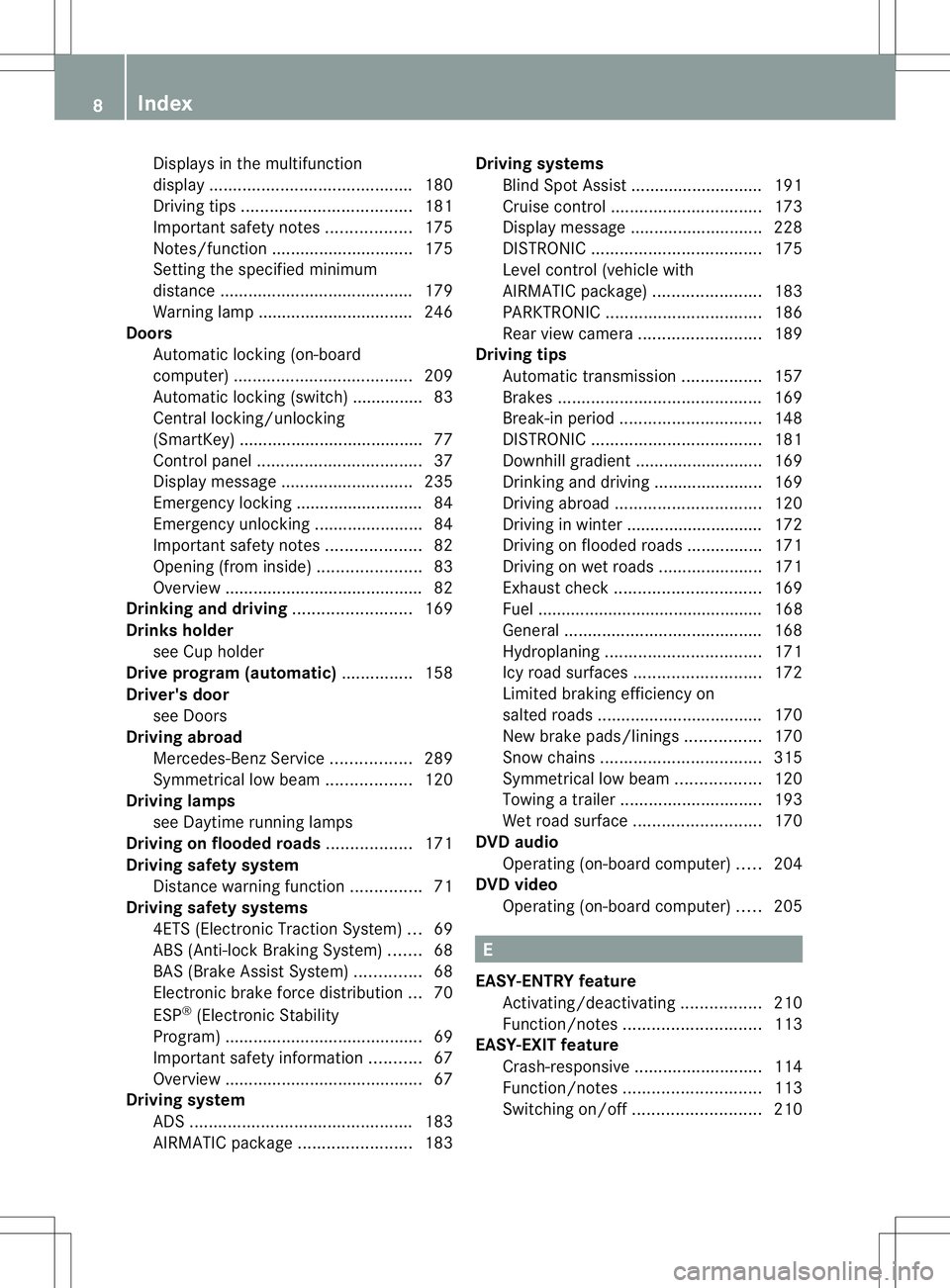
Displays in the multifunction
displa
y........................................... 180
Driving tips .................................... 181
Important safety notes ..................175
Notes/function .............................. 175
Setting the specified minimum
distance ......................................... 179
Warning lamp ................................. 246
Doors
Automatic locking (on-board
computer) ...................................... 209
Automatic locking (switch) .............. .83
Central locking/unlocking
(SmartKey) ...................................... .77
Control panel ................................... 37
Display message ............................ 235
Emergency locking ........................... 84
Emergency unlocking .......................84
Important safety notes ....................82
Opening (from inside) ......................83
Overview .......................................... 82
Drinking and driving .........................169
Drinks holder see Cuph older
Drive program (automatic) ...............158
Driver's door see Doors
Driving abroad
Mercedes-Benz Service .................289
Symmetrical low bea m.................. 120
Driving lamps
see Daytime running lamps
Driving on flooded roads ..................171
Driving safety system Distance warning function ...............71
Driving safety systems
4ETS (Electronic Traction System) ...69
ABS (Anti-lock Braking System) .......68
BAS (Brake Assist System) ..............68
Electronic brake force distribution ...70
ESP ®
(Electronic Stability
Program) .......................................... 69
Important safety information ...........67
Overview .......................................... 67
Driving system
ADS ............................................... 183
AIRMATIC package ........................183Driving systems
Blind Spot Assist ............................ 191
Cruise control ................................ 173
Display message ............................ 228
DISTRONI C.................................... 175
Level control (vehicle with
AIRMATIC package) .......................183
PARKTRONI C................................. 186
Rea rview camera .......................... 189
Driving tips
Automatic transmission .................157
Brakes ........................................... 169
Break-in period .............................. 148
DISTRONI C.................................... 181
Downhill gradient ........................... 169
Drinking and driving .......................169
Driving abroad ............................... 120
Driving in winter ............................ .172
Driving on flooded road s................ 171
Driving on wet road s...................... 171
Exhaus tcheck ............................... 169
Fuel ................................................ 168
General .......................................... 168
Hydroplaning ................................. 171
Icy road surfaces ........................... 172
Limited braking efficiency on
salted roads. .................................. 170
New brake pads/linings ................170
Snow chains .................................. 315
Symmetrical low beam. .................120
Towing atrailer .............................. 193
Wet road surface ........................... 170
DVD audio
Operating (on-board computer) .....204
DVD video
Operating (on-board computer) .....205 E
EASY-ENTRY feature Activating/deactivating .................210
Function/notes ............................. 113
EASY-EXIT feature
Crash-responsive ........................... 114
Function/notes ............................. 113
Switching on/off ........................... 2108
Index
Page 13 of 364
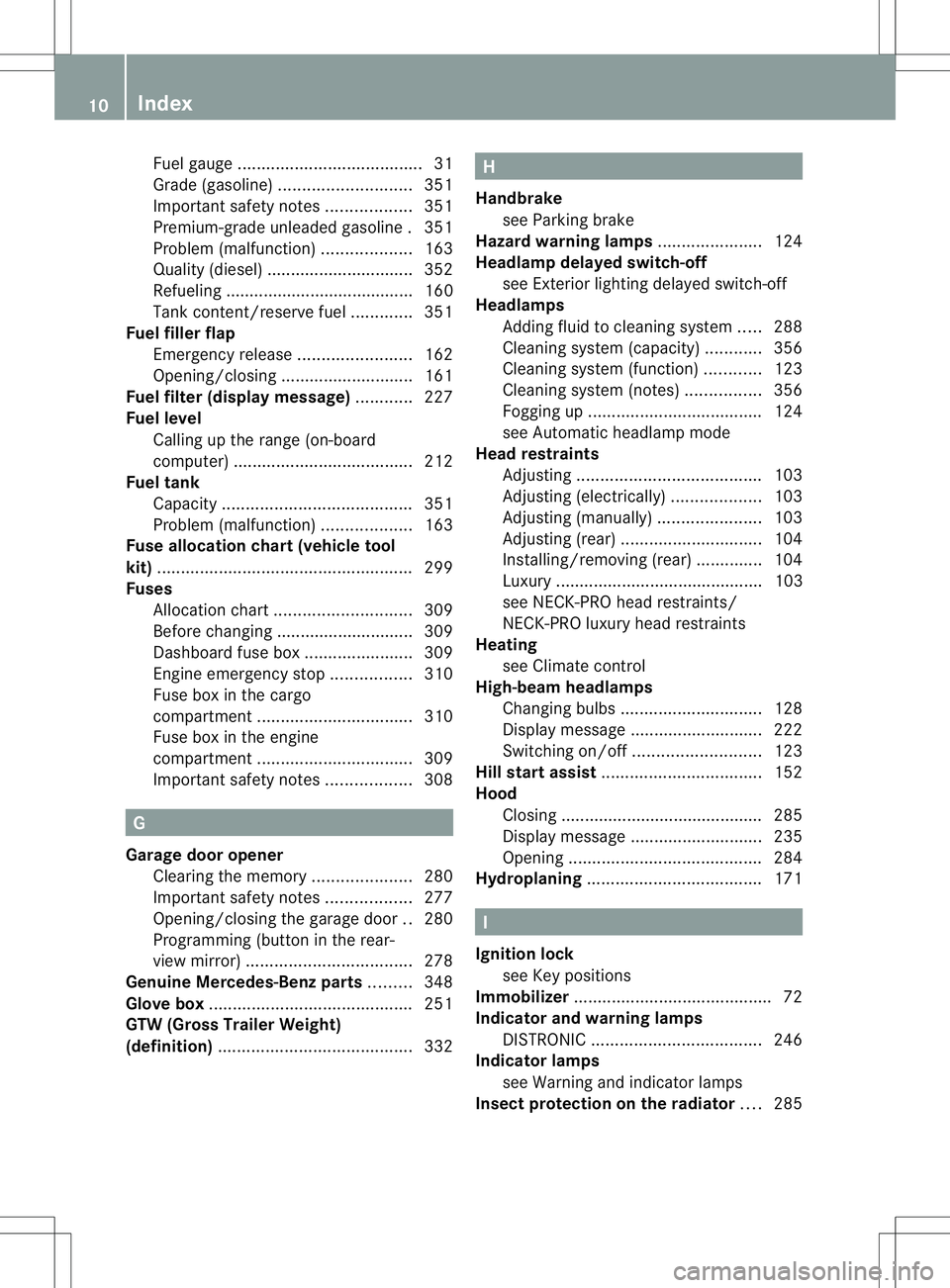
Fue
lgauge ....................................... 31
Grade (gasoline) ............................ 351
Important safety notes ..................351
Premium-grade unleaded gasoline .351
Problem (malfunction) ...................163
Quality (diesel). .............................. 352
Refueling ........................................ 160
Tank content/reserve fuel .............351
Fuel filler flap
Emergency release ........................162
Opening/closing ............................ 161
Fuel filte r(display message) ............227
Fuel level Calling up the range (on-board
computer) ...................................... 212
Fuel tank
Capacity ........................................ 351
Problem (malfunction) ...................163
Fuse allocation chart (vehicle tool
kit) ...................................................... 299
Fuses Allocation chart ............................. 309
Before changing ............................. 309
Dashboard fuse box .......................309
Engine emergency stop .................310
Fuse box in the cargo
compartment ................................. 310
Fuse box in the engine
compartment ................................. 309
Important safety notes ..................308 G
Garage door opener Clearing the memory .....................280
Important safety notes ..................277
Opening/closing the garage door ..280
Programming (button in the rear-
view mirror) ................................... 278
Genuine Mercedes-Benz parts .........348
Glove box ........................................... 251
GTW (Gross Trailer Weight)
(definition) ......................................... 332 H
Handbrake see Parking brake
Hazard warning lamps ......................124
Headlamp delayed switch-off see Exterior lighting delayed switch-off
Headlamps
Adding fluid to cleaning system .....288
Cleaning system (capacity )............ 356
Cleaning system (function) ............123
Cleaning system (notes) ................356
Fogging up ..................................... 124
see Automatic headlamp mode
Head restraints
Adjusting ....................................... 103
Adjusting (electrically). ..................103
Adjusting (manually). .....................103
Adjusting (rear) .............................. 104
Installing/removing (rear) ..............104
Luxury ............................................ 103
see NECK-PRO head restraints/
NECK-PRO luxury head restraints
Heating
see Climate control
High-beam headlamps
Changing bulbs .............................. 128
Display message ............................ 222
Switching on/off ........................... 123
Hill start assist .................................. 152
Hood Closing .......................................... .285
Display message ............................ 235
Opening ......................................... 284
Hydroplaning ..................................... 171 I
Ignition lock see Key positions
Immobilizer .......................................... 72
Indicator and warning lamps DISTRONI C.................................... 246
Indicator lamps
see Warning and indicator lamps
Insectp rotection on the radiator ....285 10
Index
Page 21 of 364
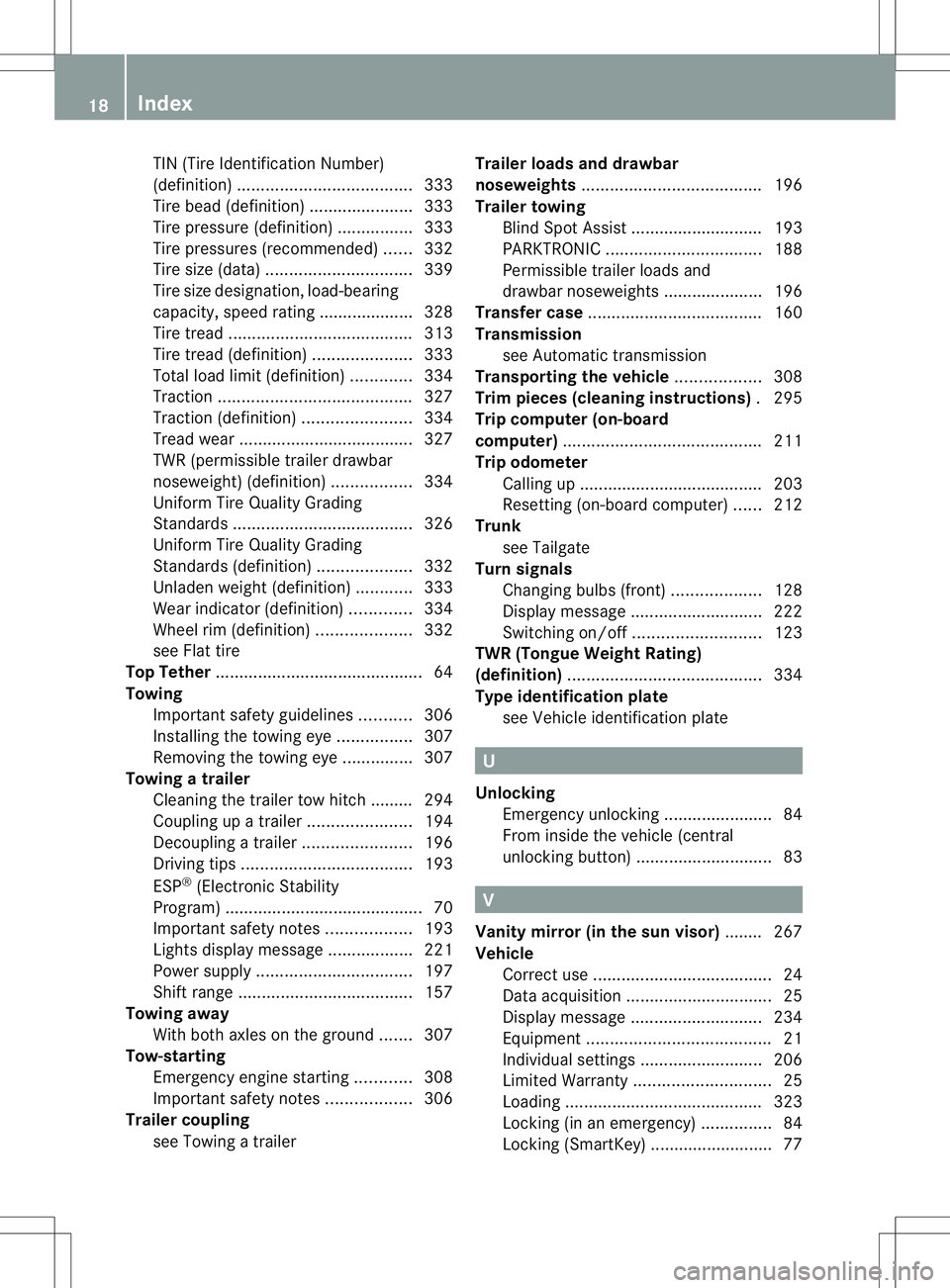
TIN (Tire Identification Number)
(definition
)..................................... 333
Tire bead( definition) ...................... 333
Tire pressure (definition) ................333
Tire pressures (recommended )...... 332
Tire size (data) ............................... 339
Tire size designation, load-bearing
capacity, speed rating .................... 328
Tire tread ....................................... 313
Tire tread (definition) .....................333
Total load limit (definition) .............334
Traction ......................................... 327
Traction (definition) .......................334
Trea dwear ..................................... 327
TWR (permissible trailer drawbar
noseweight) (definition) .................334
Uniform Tire Quality Grading
Standard s...................................... 326
Uniform Tire Quality Grading
Standard s(definition) .................... 332
Unladen weight (definition) ............333
Wea rindicato r(definition) .............334
Whee lrim (definition ).................... 332
see Flat tire
Top Tether ............................................ 64
Towing Important safety guidelines ...........306
Installing the towing eye ................307
Removing the towing eye. ..............307
Towing atrailer
Cleaning the trailer tow hitch ......... 294
Coupling up atrailer ...................... 194
Decoupling atrailer ....................... 196
Driving tips .................................... 193
ESP ®
(Electronic Stability
Program) .......................................... 70
Important safety notes ..................193
Lights displaym essage.................. 221
Power supply ................................. 197
Shift range ..................................... 157
Towing away
With both axles on the ground .......307
Tow-starting
Emergency engine starting ............308
Important safety notes ..................306
Trailer coupling
see Towing atrailer Trailer loads and drawbar
noseweights
...................................... 196
Trailer towing Blind Spot Assist ............................ 193
PARKTRONI C................................. 188
Permissible trailer loads and
drawbarn oseweights ..................... 196
Transfer case ..................................... 160
Transmission see Automatic transmission
Transporting the vehicle ..................308
Trim pieces (cleaning instructions) .295
Trip computer (on-board
computer) .......................................... 211
Trip odometer Calling up ....................................... 203
Resetting (on-board computer) ......212
Trunk
see Tailgate
Turn signals
Changing bulbs (front) ...................128
Display message ............................ 222
Switching on/off ........................... 123
TWR (Tongue Weight Rating)
(definition) ......................................... 334
Type identification plate see Vehicle identification plate U
Unlocking Emergency unlocking .......................84
From inside the vehicle (central
unlocking button) ............................. 83 V
Vanity mirror (in the sun visor) ........267
Vehicle Correct use ...................................... 24
Data acquisition ............................... 25
Display message ............................ 234
Equipment ....................................... 21
Individua lsettings .......................... 206
Limited Warranty ............................. 25
Loading .......................................... 323
Locking (in an emergency) ...............84
Locking (SmartKey) .......................... 77 18
Index
Page 74 of 364
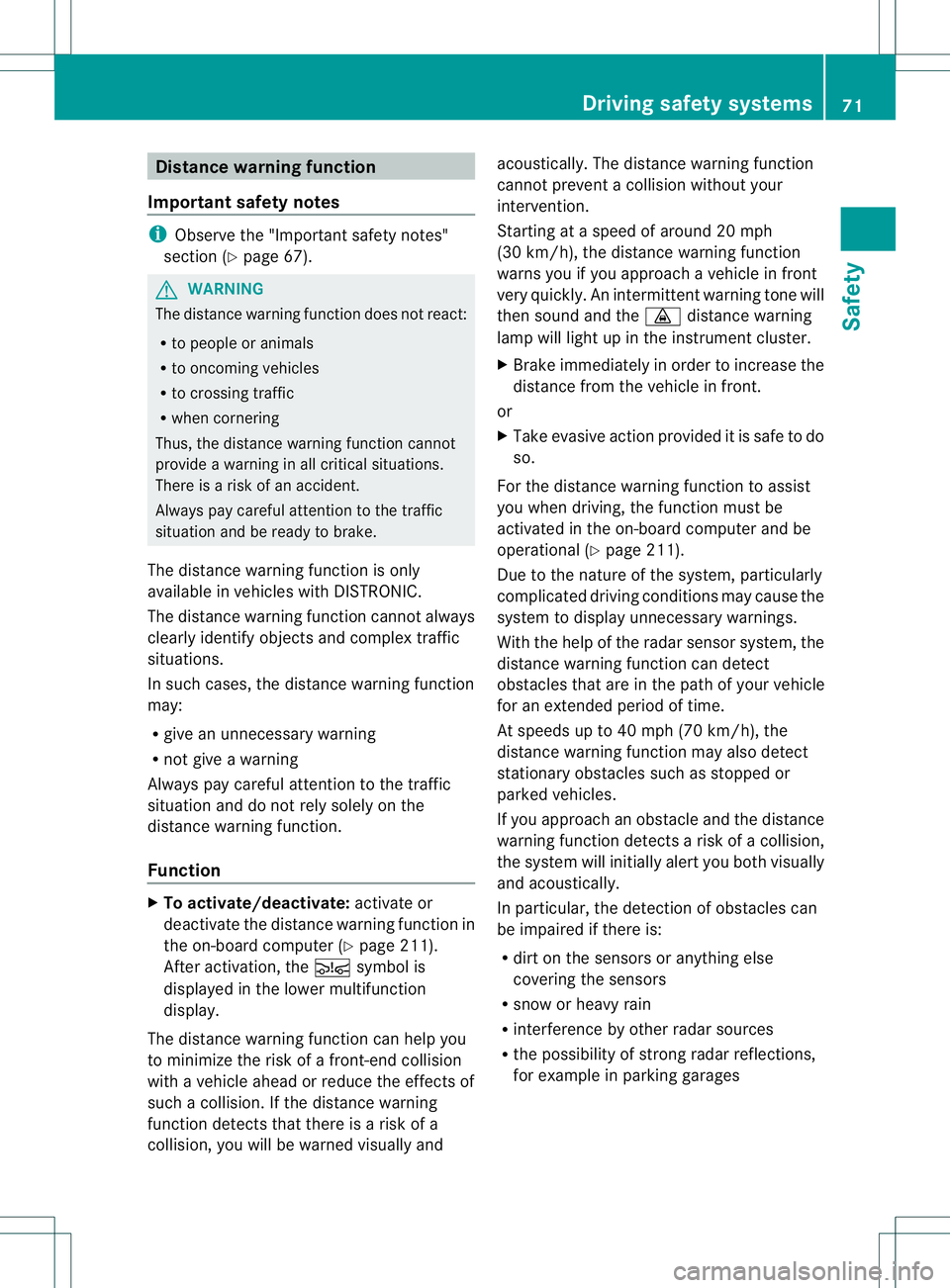
Distance warning function
Important safety notes i
Observe the "Important safety notes"
section (Y page 67). G
WARNING
The distance warning function does no treact:
R to people or animals
R to oncoming vehicles
R to crossing traffic
R when cornering
Thus, the distance warning function cannot
provide a warning in all critical situations.
There is a risk of an accident.
Always pay careful attention to the traffic
situation and be ready to brake.
The distance warning function is only
available in vehicles with DISTRONIC.
The distance warning function cannot always
clearly identify objects and complex traffic
situations.
In such cases, the distance warning function
may:
R give an unnecessary warning
R not give a warning
Always pay careful attention to the traffic
situation and do not rely solely on the
distance warning function.
Function X
To activate/deactivate: activate or
deactivate the distance warning function in
the on-board computer (Y page 211).
After activation, the Äsymbol is
displayed in the lower multifunction
display.
The distance warning function can help you
to minimize the risk of a front-end collision
with a vehicle ahead or reduce the effects of
such a collision. If the distance warning
function detects that there is a risk of a
collision, you will be warned visually and acoustically. The distance warning function
cannot preven
tacollision withouty our
intervention.
Starting at a speed of around 20 mph
(30 km/h), the distance warning function
warns you if you approach a vehicle in front
very quickly. An intermittentw arning tone will
then sound and the ·distance warning
lamp will light up in the instrumen tcluster.
X Brake immediately in order to increase the
distance from the vehicle in front.
or
X Take evasive action provided it is safe to do
so.
For the distance warnin gfunction to assist
you when driving, the function must be
activated in the on-board computer and be
operational ( Ypage 211).
Due to the nature of the system, particularly
complicated driving conditions may cause the
system to display unnecessary warnings.
With the help of the radar sensor system, the
distance warning function can detect
obstacles that are in the path of your vehicle
for an extended period of time.
At speeds up to 40 mph (70 km/h), the
distance warning function may also detect
stationary obstacles such as stopped or
parked vehicles.
If you approach an obstacle and the distance
warning function detects a ris kofacollision,
the system will initially alert you both visually
and acoustically.
In particular, the detection of obstacles can
be impaired if there is:
R dirt on the sensors or anything else
covering the sensors
R snow or heavy rain
R interference by othe rradar sources
R the possibility of strong radar reflections,
for example in parking garages Driving safety systems
71Safety Z
Page 129 of 364
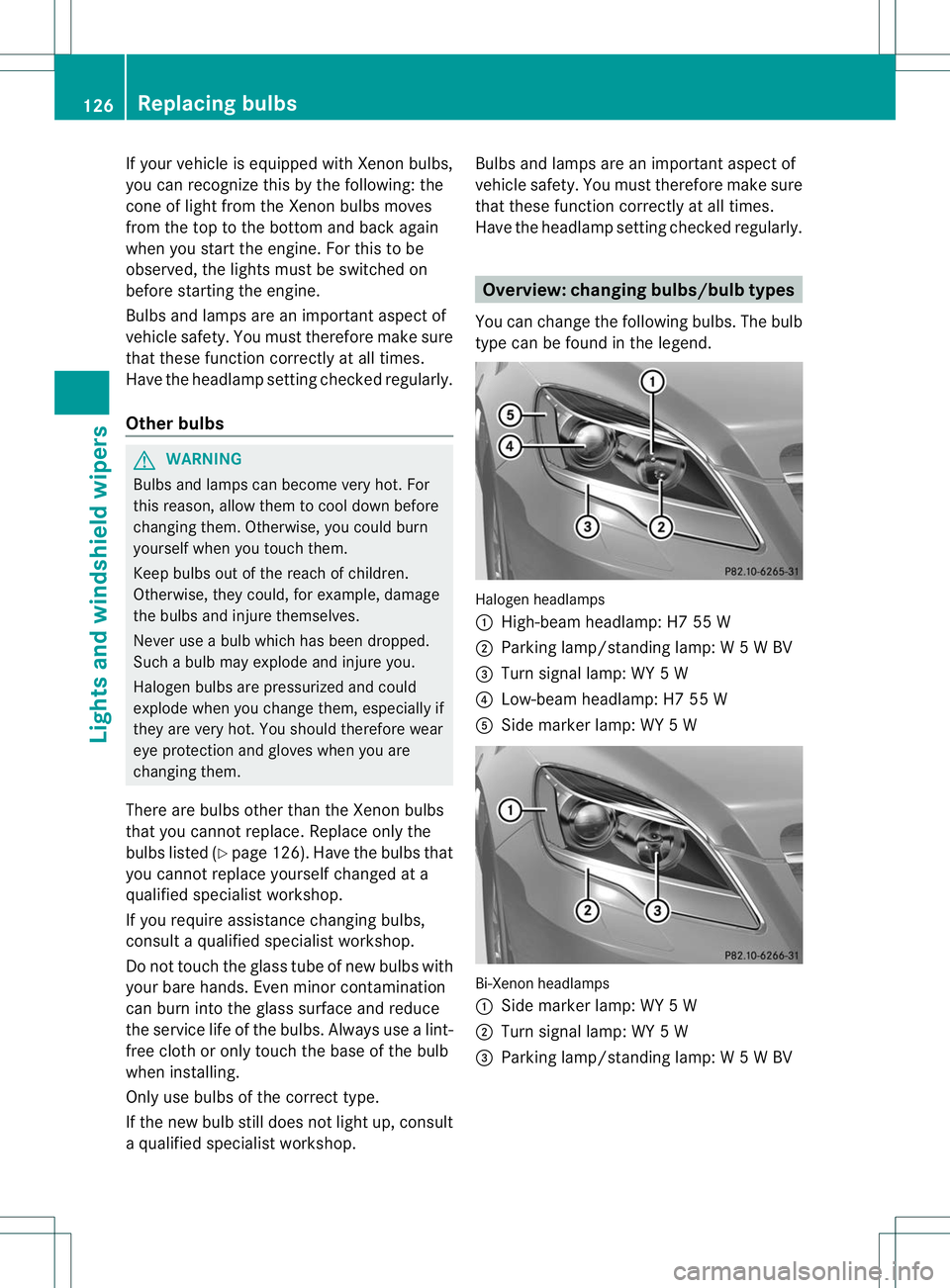
If yourv
ehicle is equipped with Xenon bulbs,
you can recognize this by the following: the
cone of light from the Xenon bulbs moves
from the top to the bottom and back again
when you start the engine. For this to be
observed, the lights must be switched on
before starting the engine.
Bulbs and lamps are an important aspect of
vehicle safety. You must therefore make sure
that these function correctly at all times.
Have the headlamp setting checked regularly.
Other bulbs G
WARNING
Bulbs and lamps can become very hot. For
this reason, allow them to cool down before
changing them. Otherwise, you could burn
yourself when you touch them.
Keep bulbs out of the reach of children.
Otherwise, they could, for example, damage
the bulbs and injure themselves.
Never use a bulb which has been dropped.
Such a bulb may explode and injure you.
Halogen bulbs are pressurized and could
explode when you change them, especially if
they are very hot. You should therefore wear
eye protection and gloves when you are
changing them.
There are bulbs other than the Xenon bulbs
that you cannot replace. Replace only the
bulbs listed (Y page 126). Have the bulbs that
you cannot replace yourself changed at a
qualified specialist workshop.
If you require assistance changing bulbs,
consult a qualified specialist workshop.
Do not touch the glass tube of new bulbs with
your bare hands. Even minor contamination
can burn into the glass surface and reduce
the service life of the bulbs. Always use a lint-
free cloth or only touch the base of the bulb
when installing.
Only use bulbs of the correct type.
If the new bulb still does not light up, consult
a qualified specialist workshop. Bulbs and lamps are an important aspect of
vehicle safety. You must therefore make sure
that these function correctly at all times.
Have the headlamp setting checked regularly. Overview: changing bulbs/bulb types
You can change the following bulbs. The bulb
type can be found in the legend. Halogen headlamps
:
High-beam headlamp: H7 55 W
; Parking lamp/standing lamp: W 5 W BV
= Turn signal lamp: WY 5W
? Low-beam headlamp: H7 55 W
A Side marker lamp: WY 5 W Bi-Xenon headlamps
:
Side marker lamp: WY 5 W
; Turn signal lamp:W Y5W
= Parking lamp/standing lamp: W 5 W BV 126
Replacing bulbsLights and windshield wipers
Page 155 of 364
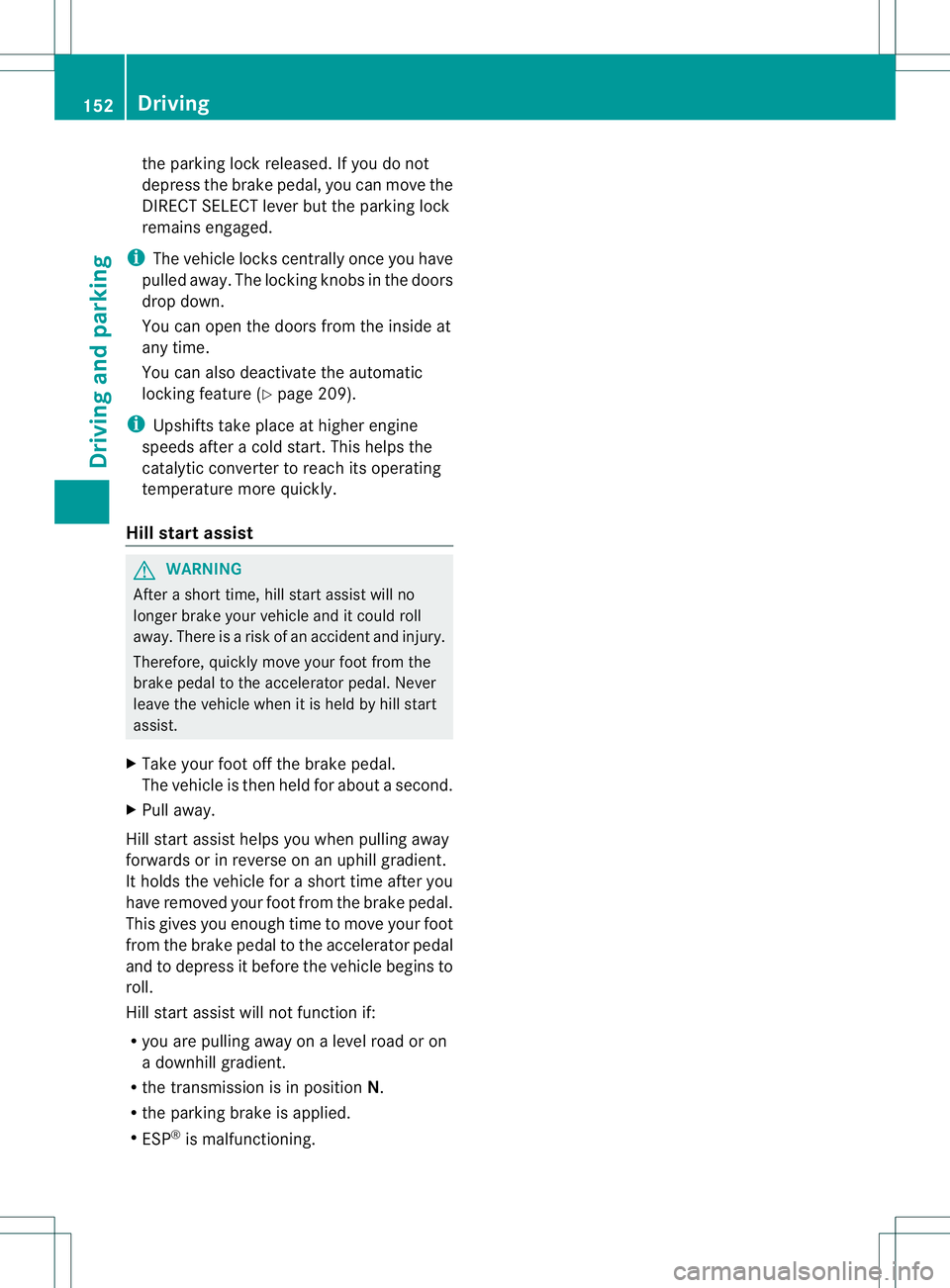
the parking lock released. If you do not
depress the brake pedal, yo
ucan move the
DIRECT SELECT lever but the parking lock
remains engaged.
i The vehicle locks centrally once you have
pulled away. The locking knobs in the doors
drop down.
You can open the doors from the inside at
any time.
You can also deactivate th eautomatic
locking feature (Y page 209).
i Upshifts take place at higher engine
speeds after a cold start .This helps the
catalytic converter to reach its operating
temperature more quickly.
Hill starta ssist G
WARNING
After a short time, hill start assist will no
longer brake your vehicle and it could roll
away. There is a risk of an accident and injury.
Therefore, quickly move your foot from the
brake pedal to the accelerator pedal. Never
leave the vehicle when it is held by hill start
assist.
X Take your foot off the brake pedal.
The vehicle is then held for about a second.
X Pull away.
Hill start assist helps you when pulling away
forwards or in reverse on an uphill gradient.
It holds the vehicle for a short time after you
have removed your foot from the brake pedal.
This gives you enough time to move your foot
from the brake pedal to the accelerator pedal
and to depress it before the vehicle begins to
roll.
Hill start assist will not function if:
R you are pulling away on a level road or on
a downhill gradient.
R the transmission is in position N.
R the parking brake is applied.
R ESP ®
is malfunctioning. 152
DrivingDriving and parking
Page 167 of 364
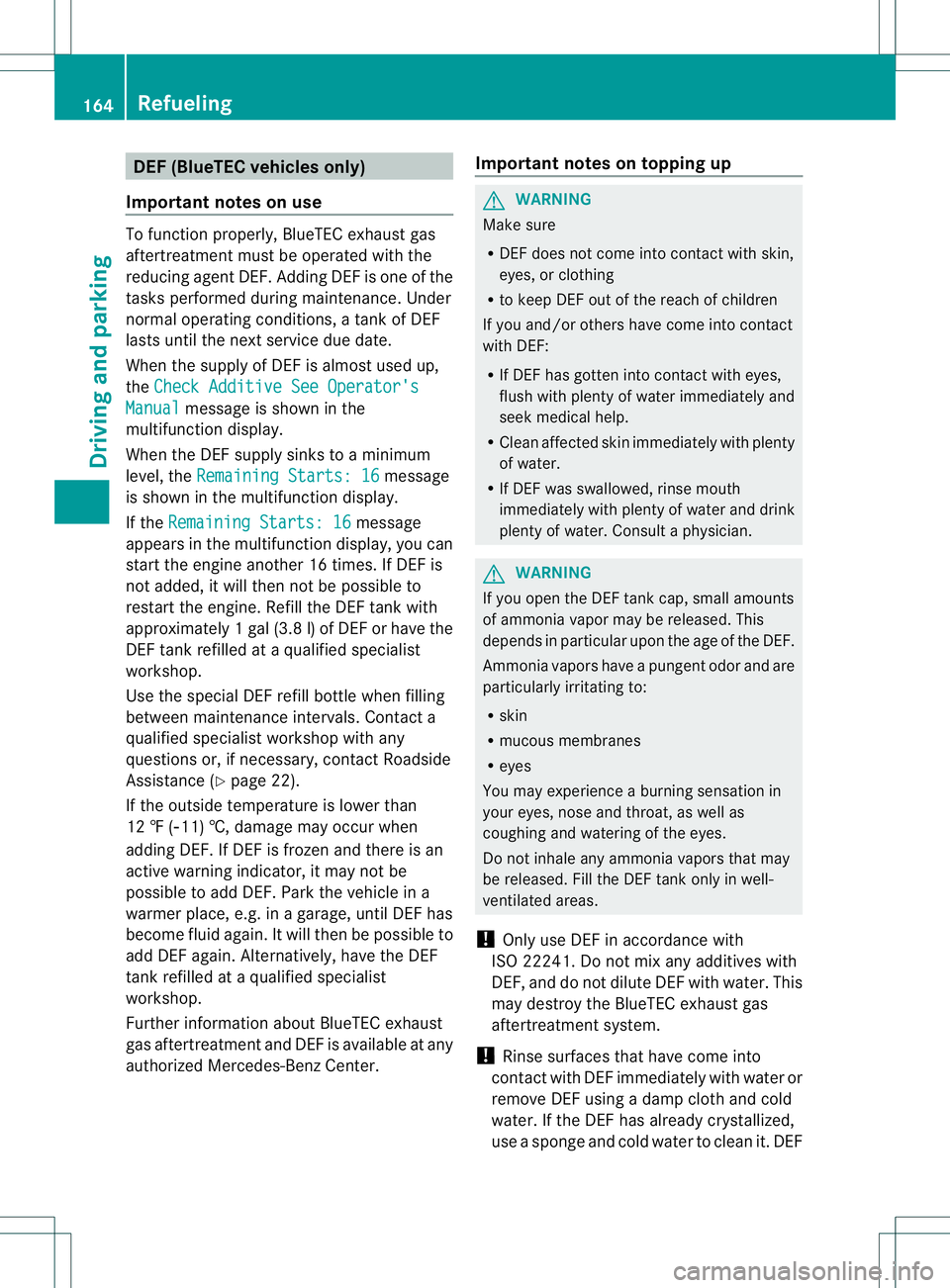
DEF (BlueTEC vehicles only)
Important notes on use To function properly, BlueTEC exhaus
tgas
aftertreatment must be operated with the
reducing agen tDEF. Adding DEF is one of the
tasks performed during maintenance. Under
normal operating conditions, a tank of DEF
lasts until the next service due date.
When the supply of DEF is almos tused up,
the Check Additive See Operator's Manual message is shown in the
multifunction display.
When the DEF supply sinks to a minimum
level, the Remaining Starts: 16 message
is shown in the multifunction display.
If the Remaining Starts: 16 message
appears in the multifunction display, you can
start the engine another 16 times. If DEF is
not added, it will then not be possible to
restart the engine. Refill the DEF tank with
approximately 1gal(3.8 l)of DEForh ave the
DE Ftank refilled at a qualified specialist
workshop.
Use the special DE Frefill bottle when filling
between maintenance intervals. Contact a
qualified specialist workshop with any
questions or, if necessary, contact Roadside
Assistance (Y page 22).
If the outside temperature is lower than
12 ‡ (Ò11) †, damage may occur when
adding DEF. If DEF is frozen and there is an
active warning indicator, it may not be
possible to add DEF. Park the vehicle in a
warmer place, e.g. in a garage, until DEFh as
become fluid again .Itwill the nbe possible to
add DEF again. Alternatively, have the DEF
tank refilled at a qualified specialist
workshop.
Further information about BlueTEC exhaust
gas aftertreatmen tand DEF is available at any
authorized Mercedes-Benz Center. Important notes on topping up G
WARNING
Make sure
R DEF does not come into contact with skin,
eyes, or clothing
R to keep DEF out of the reach of children
If you and/or others have come into contact
with DEF:
R If DEF has gotten into contact with eyes,
flush with plenty of water immediately and
see km edical help.
R Clean affected skin immediately with plenty
of water.
R If DEFw as swallowed, rinse mouth
immediately with plenty of wate rand drink
plenty of water. Consult a physician. G
WARNING
If you open the DEF tank cap, small amounts
of ammonia vapor may be released .This
depends in particular upon the age of the DEF.
Ammonia vapors have a pungent odor and are
particularly irritating to:
R skin
R mucous membranes
R eyes
You may experience a burning sensation in
your eyes, nose and throat, as well as
coughing and watering of the eyes.
Do not inhale any ammonia vapors that may
be released. Fill the DEF tank only in well-
ventilated areas.
! Only use DEF in accordance with
ISO 22241. Do not mix any additives with
DEF, and do not dilute DEF with water. This
may destroy the BlueTEC exhaust gas
aftertreatment system.
! Rinse surfaces that have come into
contact with DEF immediately with water or
remove DEF using a damp cloth and cold
water. If the DEF has already crystallized,
use a sponge and cold water to clean it. DEF 164
RefuelingDriving and parking
Page 174 of 364
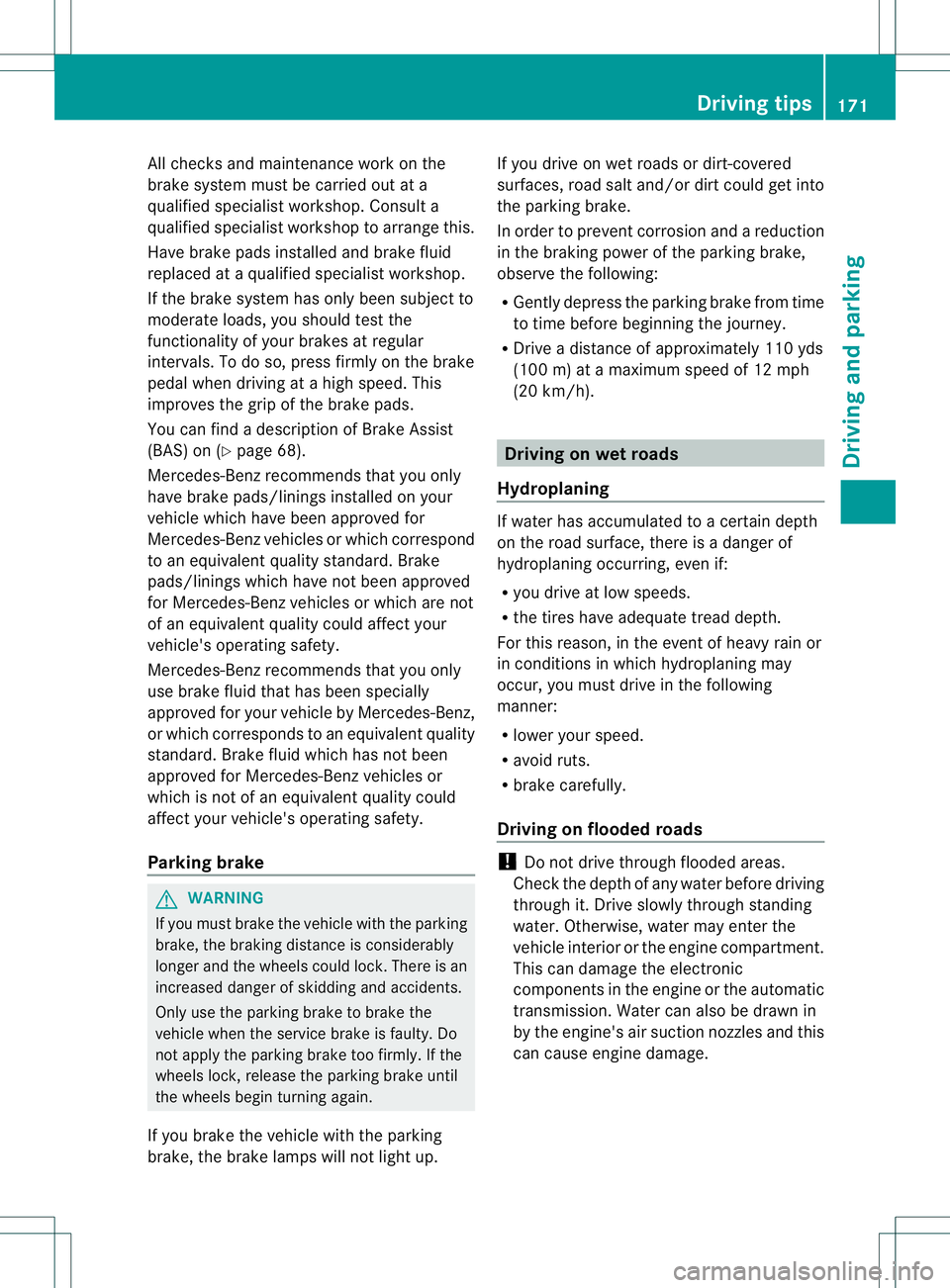
All checks and maintenance work on the
brake system must be carried ou
tata
qualified specialist workshop. Consult a
qualified specialist workshop to arrange this.
Have brake pads installed and brake fluid
replaced at a qualified specialist workshop.
If the brake system has only been subjectto
moderate loads, you should test the
functionality of yourb rakes at regular
intervals. To do so, press firmly on the brake
pedal when driving at a high speed. This
improves the grip of the brake pads.
You can find a description of Brake Assist
(BAS) on ( Ypage 68).
Mercedes-Benz recommends that you only
have brake pads/linings installed on your
vehicle which have been approved for
Mercedes-Benz vehicles or which correspond
to an equivalent quality standard .Brake
pads/linings which have not been approved
for Mercedes-Benz vehicles or which are not
of an equivalent quality could affect your
vehicle's operating safety.
Mercedes-Benz recommends that you only
use brake fluid that has been specially
approved for yourv ehicle by Mercedes-Benz,
or which corresponds to an equivalent quality
standard. Brake fluid which has not been
approved for Mercedes-Benz vehicles or
which is not of an equivalent quality could
affect your vehicle's operating safety.
Parking brake G
WARNING
If you must brake the vehicle with the parking
brake, the braking distanc eis considerably
longer and the wheels could lock. There is an
increased danger of skidding and accidents.
Only use the parking brake to brake the
vehicle when the service brake is faulty. Do
not apply the parking brake too firmly. If the
wheels lock, release the parking brake until
the wheels begin turning again.
If you brake the vehicle with the parking
brake, the brake lamps will not light up. If you drive on wet roads or dirt-covered
surfaces, road salt and/or dirt could get into
the parking brake.
In order to prevent corrosion and a reduction
in the braking power of the parking brake,
observe the following:
R
Gently depress the parking brake from time
to time before beginning the journey.
R Drive a distance of approximately 110 yds
(100 m) at a maximum speed of 12 mph
(20 km/h). Driving on wet roads
Hydroplaning If water has accumulated to a certain depth
on the road surface, there is a danger of
hydroplaning occurring, even if:
R
you drive at low speeds.
R the tires have adequate tread depth.
For this reason, in the event of heavy rain or
in conditions in which hydroplaning may
occur, you must drive in the following
manner:
R lower your speed.
R avoid ruts.
R brake carefully.
Driving on flooded roads !
Do not drive through flooded areas.
Check the depth of any water before driving
through it. Drive slowly through standing
water. Otherwise, water may enter the
vehicle interior or the engine compartment.
This can damage the electronic
components in the engine or the automatic
transmission. Water can also be drawn in
by the engine's air suction nozzles and this
can cause engine damage. Driving tips
171Driving and parking Z